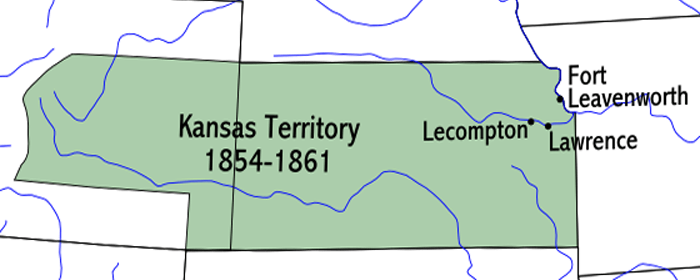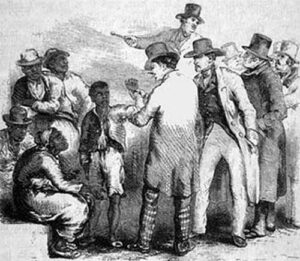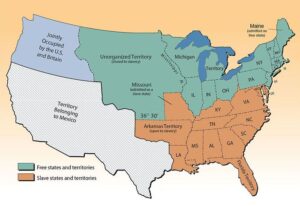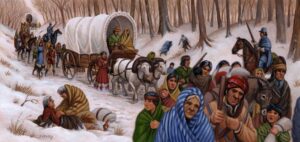The Year 1854. The year 1854 is an important one in the history of Kansas, for it brings to a close the period during which this region was used as a hunting ground by the Indians and marked the beginning of its use as a home for white people. The white settlers did not come in peace and quiet; the first dozen years following 1854 were filled with hatred, struggle, and bloodshed. Conditions brought this about outside of Kansas. As we have seen, 25 years earlier, Kansas was made an Indian territory because people in the states wanted the lands of the eastern Indians. In 1854 a terrible conflict began here because there was a division between the North and the South on the question of slavery.
The Attitude of the North and the South Toward Slavery. Slavery had existed in the United States since the very early colonial days. It had not been profitable in the northern states, but in the cotton fields of the southern plantations, slave labor was in demand, and its use after the invention of the cotton gin had increased steadily with the passing years. The Northerners had long opposed slavery and tried to keep it from spreading into the northern and western territories. At the same time, the Southerners were just as determined that it should flourish and that it should be extended into new territory. This difference between the North and the South developed great bitterness. Neither side lost any opportunity to take advantage of the other, and each was anxious to secure a majority in the Senate to obtain favorable legislation. This matter was so carefully watched that it had long been the custom to keep the “balance of power” between the states; that is, to admit free and slave states alternately to keep the number of pro-slavery and Free-State senators balanced. Because of its more rapid population growth, the North had long had a majority in the House.
The Missouri Compromise, 1820. Missouri was along the dividing line between the North and the South, and when it asked to be admitted to the Union, there followed a long debate in Congress as to whether it should come in slave or free. The question was finally settled by the Missouri Compromise, which provided that Missouri might come in as a slave state but that all the rest of the territory included in the Louisiana Purchase and lying north of 36° 30′, the line forming the southern boundary of Missouri, should be forever free. In other words, slavery was forever excluded from Kansas and the territory lying north of it. Slavery Trouble Brings on the Civil War. This was in 1820, about the time of the beginning of the Santa Fe trade. During the years when Kansas was an Indian country and was traversed by countless caravans, the country remained bound by the terms of this compromise. But all this time, the feeling of animosity between the North and the South was growing more intense; Northern churches and newspapers denounced the evils of slavery, Free-State, and abolition parties developed, and thousands of slaves were assisted in making their escape through the North to Canada despite the strict fugitive slave law. There was bitter strife in Congress between the free-state and the slave-state members. The relations between the North and the South were becoming increasingly strained. The time was rapidly approaching when the differences between the two sections were to be settled by a great war.
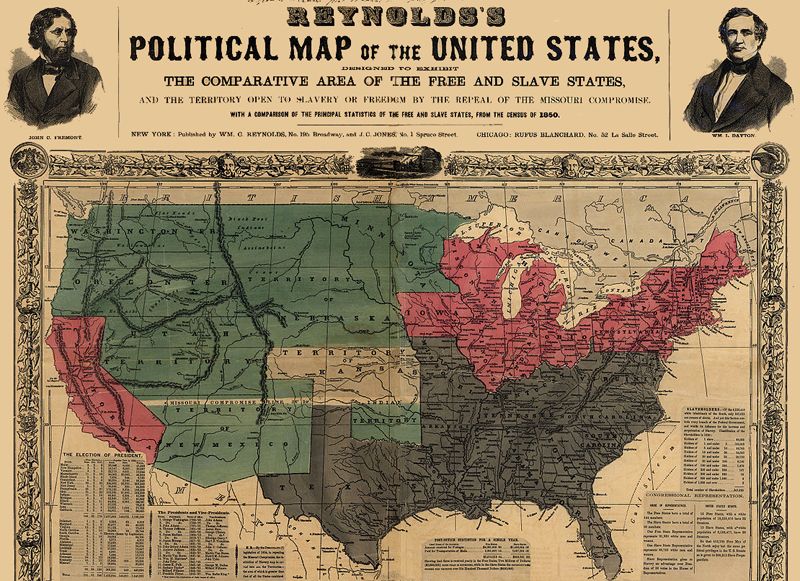
1856 map showing slave states in gray, free states in pink, U.S. territories in green, and Kansas in white.
Conflict Brought into Kansas in 1854. The Civil War began in 1861, the same year Kansas became a state. Still, seven years earlier, in 1854, Congress had passed a measure that brought slavery trouble into Kansas and made this state the battleground in the great national struggle over the slavery question.
The Kansas-Nebraska Bill, 1854. The measure passed by Congress that played such an important part in the history of Kansas and the Nation was known as the Kansas-Nebraska Bill and was the work of Senator Stephen A. Douglas of Illinois. It provided that the two territories, Kansas and Nebraska, should be organized and that the question of slavery should be left for the people of each territory to decide for themselves. This method of settling the question was known as “popular sovereignty.” Because the settlers were often called squatters, it was frequently called “squatter sovereignty.”
Reception of the Bill. Kansas and Nebraska were part of the territory which, according to the terms of the Missouri Compromise, was to be forever free. However, under the Douglas bill, they would become either slave or free, as the people who settled the territories might decide. When this bill was introduced into Congress, it raised a storm of indignation among those opposed to slavery, and the debate that ensued lasted for months. The whole North was aroused and poured forth objection and protest but to no avail. The bill was passed on May 30, 1854.
Result of the Bill. The Kansas-Nebraska Bill meant that the Missouri Compromise had been repealed and that there was no longer any boundary line against slavery. It meant that Kansas and Nebraska were offered as prizes to be contended for by the free and the slave states. The South said, “You may have Nebraska; Kansas is ours.” The North refused to recognize such a division of spoils and insisted that both territories had been carved from free soil and should come into the Union free. North and South desired to secure Kansas, and each side urged that as many of its own people as possible should emigrate to the new Territory. It could scarcely be expected that, under such circumstances, Kansas would be left for a gradual and peaceful settlement. The result was that the scene of strife was transferred from Congress to these western prairies, and from that time until the admission of the Territory as a state, the conflict between the forces of freedom and slavery was waged here.
Indians Removed from Kansas Lands. It must be remembered that at this time, Kansas was an Indian country, and many of the eastern tribes had given up their lands in exchange for lands here that had been promised to them forever. Nevertheless, the Indians were removed from Kansas, many at once and others more leisurely. They were taken to what has since become Oklahoma, where many still live. This way, room was made for the white settlers to enter Kansas.
Summary. For many years, the North and the South had bitter feelings about the slavery question. In 1820, the Missouri Compromise was passed. This measure provided that all the Louisiana Purchase lying north of the southern boundary of Missouri, except Missouri itself, should be forever free. This agreement was observed until the passage of the Kansas-Nebraska Bill in 1854. This bill provided that the settlers of each of these territories should decide whether it was to be made slave or free. Each side was determined to win Kansas, and as a result, the slavery struggle was brought here. To make room for settlers, the Indians were moved to Indian Territory, later known as Oklahoma.
Compiled & edited by Kathy Alexander/Legends of America, updated March 2024. Source: Arnold, Anna E.; The State of Kansas; Imri Zumwalt, state printer, Topeka, Kansas, 1919.
Also See:

